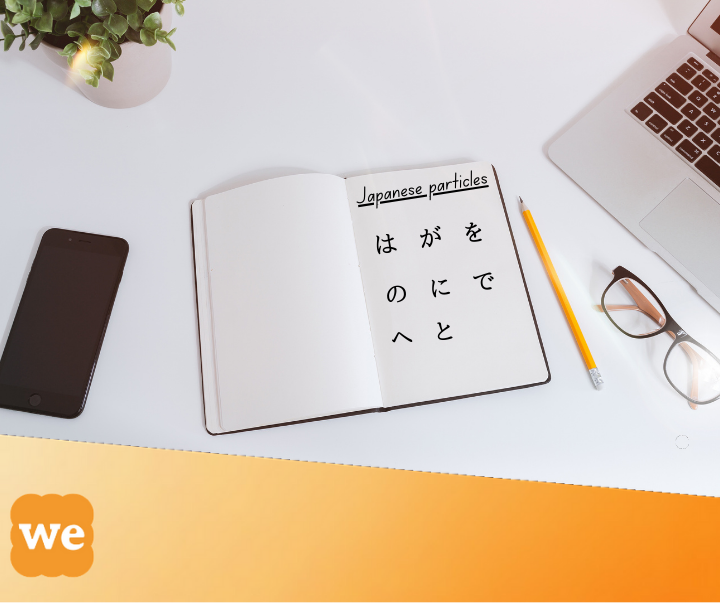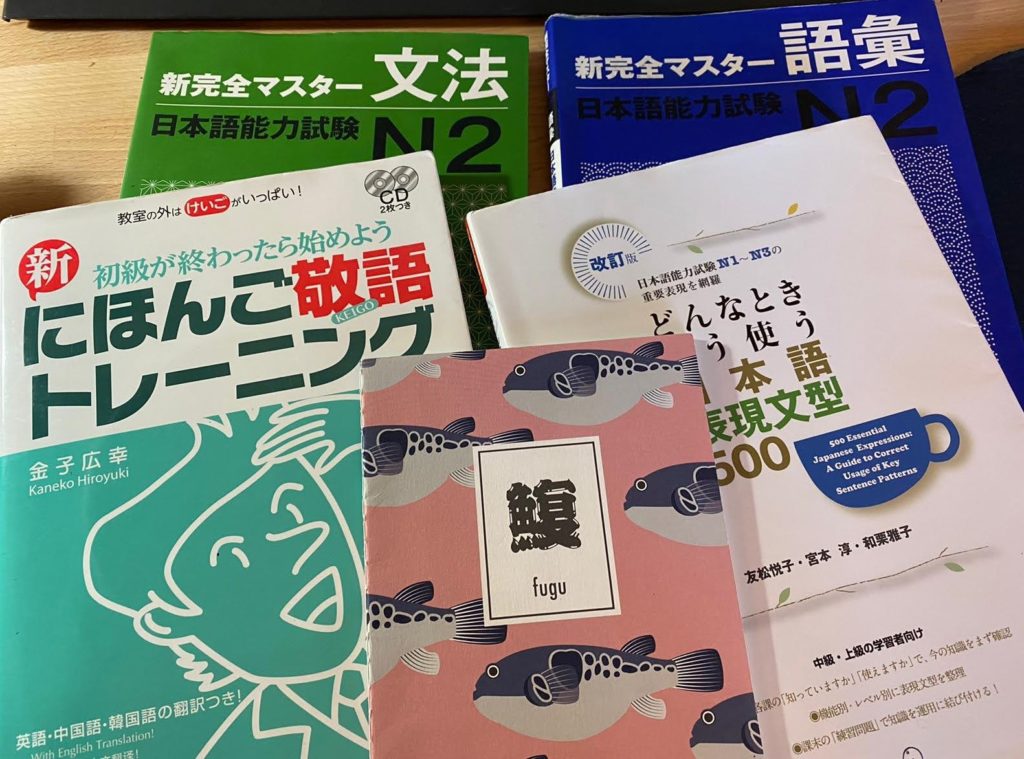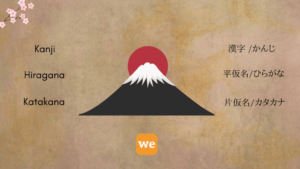
Particles are a vital part of the Japanese language. They are the modifiers that state the grammatical role of the noun they refer to and express what that noun is doing in the sentence. So how do you use particles in the Japanese language, you might ask? You will learn more about how to use the main Japanese particles in this article.
As you may know, Japanese is a SOV language, where the subject is always expressed at the beginning (can be implied) and other complements and the direct Object always precedes the verb, which is always located at the end of the sentence. This one always goes at the end of the sentence. In addition, the order of the elements is free, as you can see in this example:
京子さんは図書館で英語を勉強しています。
Kyōkosan wa toshokan de eigo wo benkyōshiteimasu.
Kyōko is studying Japanese language in the library.
京子さんは英語を図書館で勉強しています。
Kyōkosan wa eigo wo toshokan de benkyōshiteimasu.
Kyōko is studying in the library Japanese language.
Both sentences are grammatically correct, but keep in mind that the closer a complement is to the verb, the more important it is. In this example, if we consider it as the answer to the question “What is Kyōko studying?”, then we prefer the first sentence to the second one. However, if the question is “Where is Kyōko studying”, then we would choose the second one.
Things to remember about Japanese particles
Japanese particles are called 助詞 joshi , meaning literally “helping the words/text”, as the kanji 助ける tasukeru means “to help” and 詞 shi means “words or text”.
日本でお正月に大人が子供にお金をあげます。
Nihon de oshōgatsu ni otona ga kodomo ni okane wo agemasu.
In Japan, on New Year’s Day, adults give money to their children.
京子は先週りゅうじさんと教会で結婚しました。
Kyōkosan wa senshū Ryūjisan to kyōkai de kekkonshimashita.
Last week, Kyōko and Ryūji married in a church.
As you can see, each complement comes with a different particle: は for the subject, で to state the place of the action, and を for the direct object. In fact, this is exactly the role of the postpositional particles: they clarify the role of the noun or nouns they follow in a statement. Particles are always positioned after the noun they are referred to, therefore, you should be careful while using them because it's easy to cause a misunderstanding by placing them wrong.
✔ マリアさんはフォークでスパゲッティを食べます。
Mariasan wa fōku de supaghetti wo tabemasu.
Maria eats spaghetti with a fork.
✘ マリアさんはフォークをスパゲッティで食べます。
Mariasan wa fōku wo supaghetti de tabemasu.
Maria eats a fork with spaghetti.
Additionally, keep in mind that each particle can have more than one function and can state more than one complement. There are also some particles, called "Ending particles", which are always put at the end of the sentence. Knowing them will result in speaking Japanese more naturally.
In this section we will explain the most used particles to understand basic Japanese sentences.
Basic Japanese particles: は wa, が ga, を wo, and の no

The は and が particles
The particle は (wa) states the subject doing the action in the sentence. Despite it being written “ha”, it is pronounced “wa”. Here are some basic Japanese phrases:
私はイタリア人です。
Watashi wa itariajin desu.
I am Italian.
私は学生です。
Watashi wa gakusei desu.
I am a student.
- Similar to は is the particle が ga, because both state "the subject doing the action". Their role can be confusing, but keep this in mind: が is used when we want to emphasize the noun before it. Let’s look at two examples to understand it clearly.
さくらさんがこの傘はほしいです。
Sakurasan ga kono kasa wa hoshii desu.
Sakura wants this umbrella.
By placing が after “Sakura”, the emphasis is put on her, the person who wants the umbrella, as if it was the answer to the question
“Who wants the umbrella?”. Note that changing the particles order results in a slight different meaning:
さくらさんはこのかさがほしいです。
Sakurasan wa kono kasa ga hoshii desu.
This sentence emphasizes what Sakura wants, as if it was the answer to the question “What does Sakura want?”. There is no such difference in English, therefore we can translate them in the same way.
Japanese particles: を and の
を (wo) is very simple to use because it states the direct object.
私はご飯を食べます。
Watashi wa gohan wo tabemasu.
I eat rice.
サラさんは手紙を書いています。
Sarasan wa tegami wo kaiteimasu.
Sara is writing a letter.
Furthermore, を is also used to express “passing through” , “crossing something” or “leaving a place”.
家を出る。 Uchi o deru. Leaving home.
橋を渡る。 Hashi wo wataru. Crossing a bridge.
私は毎日公園を散歩します。
Watashi wa mainichi kōen wo sanposhimasu.
Everyday, I walk through the park.
- の (no) particle is the one particle you have the least chance of mixing it up. When you want to express that “N1 belongs to N2”, you say “N2の N1”. Just as in English, where we use ‘X’s’, in Japanese we say ‘X の’. Here are some axamples:
私のお父さん Watashi no otōsan My father
あなたの彼氏 Anata no kareshi Your boyfriend
桜の花 Sakura no hana. Cherry blossom
(the meaning is: cherry blossom's flower)
英語の本 Eigo no hon English book
これはだれのペンですか。
Kore wa dare no pen desuka?
Whose pen is this?
これは私のペンです。
Kore wa watashi no pen desu.
This is my pen.
Particles of Place and Direction
Main uses of に particle
The に (ni) particle has more than one using: it states the place where the subject is, referring to animate or inanimate objects.
木の上に猫がいます。
Ki no ue ni neko ga imasu.
There is a cat on the tree.
京都に住んでいます。
Kyōto ni sundeimasu.
I live in Kyōto.
机の下に傘があります。
Tsukue no shita ni kasa ga arimasu.
There is an umbrella under the desk.
- Also states the direction or the arrival point:
毎日大学に行きます。
Mainichi daigaku ni ikimasu.
I go to University every day.
今朝ローマに着きました。
Kesa Rōma ni tsukimashita.
I arrived in Rome this morning.
- In addition, に expresses the time when the action occurs. Note that when you state something as “today, this week, this month” the particle is not mandatory, as in the previous sentence.
今日は9時に起きました。
Kyō wa kuji ni okimashita.
Today I woke up at 9 o’clock.
電車は10時に出発します。
Densha wa jūji ni shuppatsushimasu.
The train leaves at 10.
- Combined with the verb なります narimasu to express a changing that occurs:
元気になります / 病気になります。
Genki ni narimashita / Byōki ni narimashita.
To become healthy/sick.
今月18歳になります。
Kongetsu jūhachi ni narimasu.
I will be 18 this month.
「将来何になりたいの?」 「医者になりたい」
Shōrai nani ni naritai? Isha ni naritai.
What do you want to be in the future? I want to become a doctor.
The へ particle
The へ he particle generally states the destination point. It can be used in the same way as に, but this one specifies more the “towards” meaning, both with a verb of movement and to express “for” someone.
ローマへ向かう。
Rōma he mukau.
Heading towards Rome.
東京へ行く。
Tōkyō he iku.
Going to Tōkyō.
こちらへどうぞ。
Kochira he dōzo.
Come this way, please.
お母さんへ手紙をかきます。
Okāsan he tegami wo kakimasu.
Write a letter to one’s mother.
春子ちゃんへのプレゼント。
Harukochan he no purezento.
A present for Haruko.
Moreover, you can use two particles together, like in this case: the present is for Haruko, so you will have to use 春子へ, but at the same time it is also her present, Haruko’s present, so you need to state that too with 春子のプレゼント. Putting the two particles together results in the last sentence, with “N1へのN2”.
Main uses of the で particle
で de is usually translated with prepositions “at”, “in”, and “on”, but has various meanings:
- Place where the action occurs
田舎で イタリアで 日本で 暮らす。
Inaka de/Itaria de/Nihon de kurasu.
Living in the countryside/in Italy/in Japan.
私の家でパーティーをする。
Watashi no uchi de pātī wo suru.
Have a party in my house.
庭で遊ぶ。
Niwa de asobu.
Playing in the garden,
- With transportation words, and to state the complement that specifies the tool
列車で Ressha de With the train
飛行機で Hikōki de With the aeroplane
お箸でうまく食べられません。
Ohashi de umaku taberaremasen.
I can’t eat well with chopsticks.
辞書で単語を調べます。
Jisho de tango wo shirabemasu.
Look up a word using the dictionary.
- To express the materials of which things are done
紙でできている人形
Kami de dekiteiru ningyō.
A doll made of paper.
木でできたスプーン
Ki de dekita supūn.
A spoon made of wood.
- To express the complement that specifies the cause:
今日は雨で出かけられませんでした。
Kyō wa ame de dekakeraremasendeshita.
I couldn’t go out today because of the rain.
父は戦争で死んだ。
Chichi wa sensō de shinda.
My father died because of the war./ My father died in the war.
- To express time:
この店は8時で閉める。
Kono mise ha hachiji de shimeru.
This store closes at eight.
30分で戻ってきます。
Sanjuppun de modottekimasu.
I’ll be back in half an hour.
3時間で仕事を終わりました。
Sanjikan de shigoto wo owarimashita.
I finished the work in 3 hours.
と: the particle of company
と to is used to express “company”, and it is usually translated as “with” and “against”...
友達と旅行しました。
Tomodachi to ryōkōshimashita.
I traveled with my friend.
セーターとジーンズを買った。
Sētā to jinzu wo katta.
I bought a sweater and a pair of jeans.
第二次世界大戦で日本は米国と戦った。
Dainijisekaitaisen de nihon wa beikoku to tatakatta.
Japan fought against the U.S. in World War II.
... But it is also used to express a comparison:
彼の考えは私と違います。
Kare no kangae wa watashi to chiagaimasu.
His ideas are different from mine.
りんごとオレンジとどちらが好きですか。
Ringo to orenji to dochira ga sukidesuka?
Which one do you prefer, the apple or the orange?
Hope this will help you learn Japanese grammar faster!
Author: Valeria (graduated at Ca’Foscari University Japanese Studies)



Hi we-japan.com webmaster, Your posts are always well thought out.